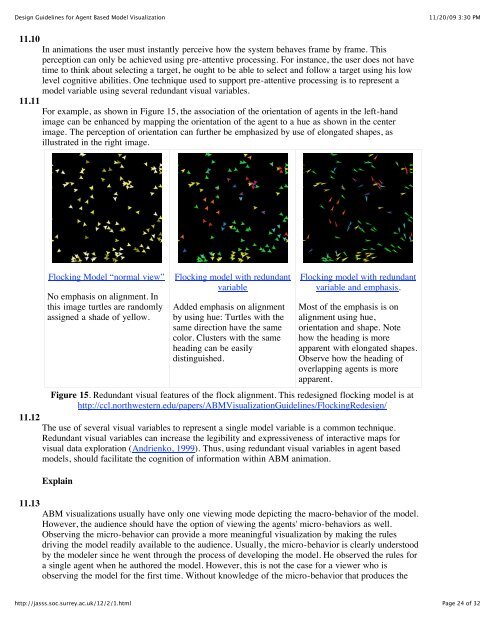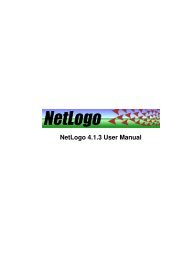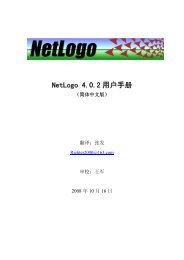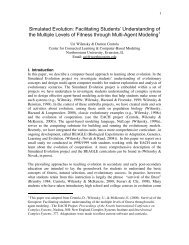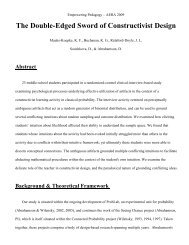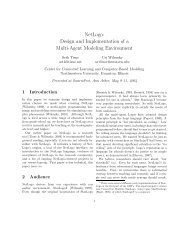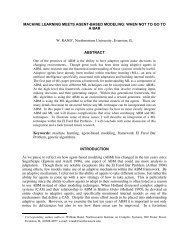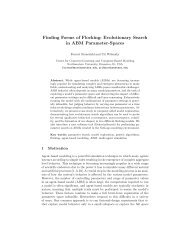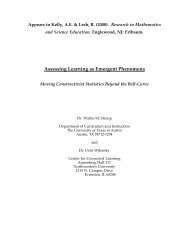Design Guidelines for Agent Based Model Visualization
Design Guidelines for Agent Based Model Visualization
Design Guidelines for Agent Based Model Visualization
Create successful ePaper yourself
Turn your PDF publications into a flip-book with our unique Google optimized e-Paper software.
<strong>Design</strong> <strong>Guidelines</strong> <strong>for</strong> <strong>Agent</strong> <strong>Based</strong> <strong>Model</strong> <strong>Visualization</strong><br />
11.10<br />
In animations the user must instantly perceive how the system behaves frame by frame. This<br />
perception can only be achieved using pre-attentive processing. For instance, the user does not have<br />
time to think about selecting a target, he ought to be able to select and follow a target using his low<br />
level cognitive abilities. One technique used to support pre-attentive processing is to represent a<br />
model variable using several redundant visual variables.<br />
11.11<br />
For example, as shown in Figure 15, the association of the orientation of agents in the left-hand<br />
image can be enhanced by mapping the orientation of the agent to a hue as shown in the center<br />
image. The perception of orientation can further be emphasized by use of elongated shapes, as<br />
illustrated in the right image.<br />
11.12<br />
11.13<br />
Flocking <strong>Model</strong> “normal view”<br />
No emphasis on alignment. In<br />
this image turtles are randomly<br />
assigned a shade of yellow.<br />
http://jasss.soc.surrey.ac.uk/12/2/1.html<br />
Flocking model with redundant<br />
variable<br />
Added emphasis on alignment<br />
by using hue: Turtles with the<br />
same direction have the same<br />
color. Clusters with the same<br />
heading can be easily<br />
distinguished.<br />
Flocking model with redundant<br />
variable and emphasis.<br />
Most of the emphasis is on<br />
alignment using hue,<br />
orientation and shape. Note<br />
how the heading is more<br />
apparent with elongated shapes.<br />
Observe how the heading of<br />
overlapping agents is more<br />
apparent.<br />
Figure 15. Redundant visual features of the flock alignment. This redesigned flocking model is at<br />
http://ccl.northwestern.edu/papers/ABM<strong>Visualization</strong><strong>Guidelines</strong>/FlockingRedesign/<br />
The use of several visual variables to represent a single model variable is a common technique.<br />
Redundant visual variables can increase the legibility and expressiveness of interactive maps <strong>for</strong><br />
visual data exploration (Andrienko, 1999). Thus, using redundant visual variables in agent based<br />
models, should facilitate the cognition of in<strong>for</strong>mation within ABM animation.<br />
Explain<br />
ABM visualizations usually have only one viewing mode depicting the macro-behavior of the model.<br />
However, the audience should have the option of viewing the agents' micro-behaviors as well.<br />
Observing the micro-behavior can provide a more meaningful visualization by making the rules<br />
driving the model readily available to the audience. Usually, the micro-behavior is clearly understood<br />
by the modeler since he went through the process of developing the model. He observed the rules <strong>for</strong><br />
a single agent when he authored the model. However, this is not the case <strong>for</strong> a viewer who is<br />
observing the model <strong>for</strong> the first time. Without knowledge of the micro-behavior that produces the<br />
11/20/09 3:30 PM<br />
Page 24 of 32


